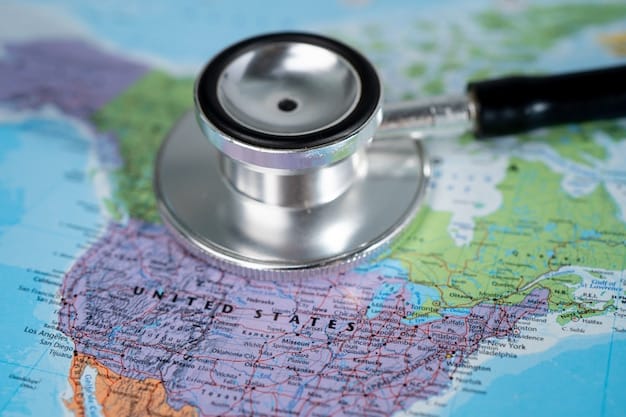Mexico’s Healthcare Reforms: Access for US Citizens Analyzed

Mexico’s healthcare reforms, particularly those influencing the public health system, present a complex landscape for improving access to medical services, potentially impacting uninsured or underinsured US citizens seeking affordable care, although challenges like quality consistency and accessibility remain prevalent.
Understanding the evolving landscape of Mexican healthcare is crucial, especially for US citizens frequently traveling or residing there. This article delves into Analyzing the Impact of Mexico’s Healthcare Reforms on Access to Medical Services for US Citizens, exploring how recent policy changes and ongoing efforts affect their ability to secure quality medical attention south of the border.
Understanding Mexico’s Shifting Healthcare Landscape
Mexico’s healthcare system has long been a complex tapestry of public, private, and hybrid models. For decades, it has served as a beacon for many US citizens seeking more affordable medical procedures, prescriptions, and dental care than typically found north of the border. However, the system is not static; it undergoes continuous reforms aimed at broadening coverage and improving quality, albeit with varying degrees of success and impact.
Recent years have seen significant legislative changes and strategic investments, particularly under the current administration, to strengthen public health institutions. These reforms are often driven by a desire to achieve universal healthcare coverage, reduce out-of-pocket expenses for citizens, and enhance the overall standard of medical services available nationwide. While primarily designed for Mexican nationals, these shifts invariably ripple outwards, influencing the experiences of US citizens who rely on or interact with the country’s medical facilities.
Key Reforms and Their Intent
The past few years have brought forth several pivotal reforms. One of the most notable is the transition away from the Seguro Popular program towards the Instituto de Salud para el Bienestar (INSABI), which aimed to provide free medical care, medicines, and examinations to all uninsured Mexicans. While INSABI itself has recently undergone further restructuring, its underlying principle of universal access continues to guide policy decisions.
- Increased Public Funding: A stated goal of recent reforms has been to allocate more federal resources to public hospitals and clinics, intended to improve infrastructure and staffing.
- Focus on Primary Care: There has been an emphasis on strengthening primary care networks, recognizing their role in preventative health and early disease detection.
- Centralization Efforts: Some reforms sought to centralize aspects of healthcare procurement and administration, aiming for greater efficiency and reduced corruption.
Despite these intentions, the implementation of such sweeping changes is rarely seamless. Administrative challenges, budget allocation complexities, and regional disparities often create a gap between policy intent and on-the-ground reality. This dynamic environment necessitates a nuanced understanding for US citizens contemplating healthcare options in Mexico.
As Mexico continues to fine-tune its healthcare model, these foundational changes directly influence the accessibility, affordability, and quality of care that US citizens can expect. Whether through direct utilization of public facilities in emergencies or via interactions with an increasingly regulated private sector, understanding these systemic shifts is paramount.
Accessibility of Public Healthcare for US Citizens
The question of whether US citizens can access Mexico’s public healthcare system is nuanced. Technically, public health services like those offered by the Secretaría de Salud (SSA) hospitals are primarily intended for Mexican citizens and legal residents. However, in emergency situations, anyone in Mexico, regardless of nationality, can receive care. This often means initial stabilization and critical intervention are provided, but continued, non-emergency care may require payment or transfer to a private facility.
With the gradual phasing out of programs like INSABI and the shift back to a more insurance-based model, albeit still with strong government subsidies for certain segments of the population, direct free access for foreigners becomes increasingly limited. US citizens without Mexican residency or a formal affiliation with the public system (like through a Mexican employer) are generally expected to pay for services received in public hospitals, even if the costs are significantly lower than in the US.
Emergency Services and Limitations
Public emergency rooms in Mexico are legally obligated to provide care to anyone in acute distress. This is a critical safety net for US tourists or residents who face sudden medical events. However, the quality and resources of public emergency facilities can vary significantly depending on their location, with major urban centers generally having better-equipped hospitals than rural areas.
- Resource Disparities: Public hospitals, especially outside major cities, may face shortages of specialized equipment, medications, or personnel.
- Language Barriers: English-speaking staff are less common in public facilities compared to private ones, potentially complicating communication during critical moments.
- Capacity Issues: Overcrowding is a frequent challenge in public hospitals, leading to longer wait times and less personalized attention.
It’s important for US citizens who might rely on public facilities in an emergency to understand these limitations and to have contingency plans, such as travel insurance that covers medical evacuations to higher-quality facilities or even back to the US if necessary. The aim of Mexican healthcare reforms, while laudable in their intent to provide universal coverage for their own population, does not automatically translate into free or unlimited access for non-citizens, particularly for non-emergency or elective procedures.

The reforms are fundamentally reshaping how healthcare is administered and funded within Mexico, emphasizing a focus on domestic needs. While this doesn’t explicitly exclude foreigners in crisis, it underlines the importance for US citizens to have adequate private insurance or be prepared for out-of-pocket costs when seeking medical care in Mexico, especially for non-critical conditions or if they wish to access the typically higher standards found in the private sector.
Impact on the Private Healthcare Sector
While much of the overt discussion surrounding Mexico’s healthcare reforms centers on the public sector, these changes inevitably cast a long shadow over the private healthcare landscape. The private sector in Mexico has traditionally been the preferred choice for many US citizens, thanks to its higher standards of amenities, often English-speaking staff, and elective procedures at a fraction of US costs. However, reforms aimed at strengthening the public system can subtly influence the private sector through various mechanisms.
One direct impact can be observed in the availability of medical professionals. If public sector salaries and working conditions improve significantly, it could potentially draw some talent away from the private sector or increase the bargaining power of medical staff. Conversely, if public sector reforms create inefficiencies or a perceived decline in care for Mexican citizens, it might drive more wealthy Mexicans towards private care, potentially increasing demand and affecting pricing.
Furthermore, regulatory changes, even those primarily targeting the public sphere, can sometimes spill over into the private domain. For instance, new standards for medical equipment, licensure, or drug procurement might be introduced across the board, affecting both public and private providers. This could lead to increased operational costs for private clinics and hospitals, which may then be passed on to patients.
Quality and Cost Implications
For US citizens, the quality of private healthcare in Mexico generally remains high, particularly in border cities and major population centers like Mexico City, Guadalajara, and Monterrey. These facilities often boast state-of-the-art equipment, internationally trained physicians, and accreditation that rivals US standards. The reforms have not, to date, demonstrably diminished this quality.
- Stable Quality: Private hospitals continue to offer high-quality care, appealing to medical tourists and expat communities.
- Potential Price Adjustments: While historically much cheaper than in the US, some upward pressure on private healthcare costs might occur due to inflation, increased demand, or regulatory compliance.
- Insurance Acceptance: Many private Mexican hospitals have relationships with international travel insurance providers, making it easier for US citizens to manage costs.
The private healthcare sector in Mexico is dynamic and competitive, continually adapting to market forces and regulatory changes. While government reforms primarily focus on public health, the private sector’s role as a major employer of medical professionals and provider of specialized services means it is interconnected. US citizens seeking care in Mexico should continue to vet private providers carefully, checking for certifications, patient reviews, and clear pricing structures.
This dynamic ensures that the private sector remains a viable, often superior, option for US citizens, but it’s important to recognize that it operates within the broader context of Mexico’s evolving healthcare policy, which can indirectly influence its practices and economic viability.
Telemedicine and Cross-Border Care Solutions
The COVID-19 pandemic significantly accelerated the adoption and acceptance of telemedicine across the globe, and Mexico was no exception. This shift has profound implications for US citizens seeking medical consultations or follow-up care from Mexican providers, bridging geographical divides and offering new avenues for healthcare access. Telemedicine enables patients to consult with physicians virtually, receive prescriptions (where legally permissible), and manage chronic conditions without necessarily crossing the border.
For many US citizens, particularly those living in border states or with mobility issues, telemedicine offers an unparalleled convenience. It reduces the need for travel, saves time, and can significantly lower costs associated with in-person visits, even with the already lower rates in Mexico. This modality also proves beneficial for managing non-emergency conditions, post-operative care, or obtaining second opinions from Mexican specialists.
Mexico’s healthcare reforms, while not explicitly focusing on telemedicine for cross-border patients, have generally encouraged the digital transformation of healthcare services. The greater acceptance of virtual consultations within Mexico’s own regulatory framework strengthens the ecosystem for such services, making them more robust and reliable for international patients.
Navigating Telemedicine Options
The landscape of telemedicine providers in Mexico is diverse. Many private hospitals and clinics that traditionally cater to medical tourists now offer virtual consultations. There are also dedicated telemedicine platforms emerging, connecting patients with a network of Mexican doctors.
- Regulatory Nuances: US citizens should be aware of the legal and regulatory differences regarding telemedicine across borders. Prescriptions for controlled substances, for example, often cannot be issued virtually across international lines.
- Language and License: Ensure the consulting physician is fluent in English and holds valid Mexican medical licensing.
- Data Privacy: Investigate the telemedicine platform’s data privacy policies to ensure your personal health information is protected.
Telemedicine can serve as an excellent first point of contact or a convenient follow-up mechanism. However, it is not a substitute for in-person evaluations when a physical examination, diagnostic tests, or more complex procedures are required. Its strongest utility lies in initial consultations, symptom assessment, medication reviews for non-controlled substances, and general health advice.

The rise of telemedicine, coupled with continuous advancements in digital health infrastructure, is poised to redefine how US citizens interact with Mexican healthcare providers, making access more flexible and potentially reducing reliance on physical border crossings solely for medical appointments.
Challenges and Considerations for US Citizens
Despite the potential benefits and ongoing improvements in Mexico’s healthcare system, US citizens seeking medical services there must navigate a unique set of challenges and considerations. These go beyond mere cost savings and touch on critical aspects of safety, quality assurance, and legal recourse. Understanding these factors is crucial for making informed decisions and ensuring a positive healthcare experience.
One primary concern revolves around the consistency of quality. While major hospitals in metropolitan areas often meet international standards, quality can vary significantly in smaller clinics or less regulated facilities. This disparity necessitates thorough research and due diligence before committing to any medical procedure or extensive treatment.
Another significant challenge is the insurance landscape. While some US health insurance plans may cover emergency care internationally, many do not cover elective procedures or comprehensive ongoing treatment in Mexico. This leads many US citizens to pay out-of-pocket or rely on specialized medical tourism insurance, which may have its own set of limitations and exclusions.
Key Challenges and Mitigation Strategies
Navigating language barriers, understanding local medical practices, and ensuring proper follow-up care are all vital considerations.
- Quality Assurance: Verify the credentials of doctors and the accreditation of facilities. Look for international accreditations such as Joint Commission International (JCI).
- Legal and Ethical Frameworks: Be aware that medical malpractice laws and patient rights may differ significantly from those in the US, potentially complicating legal recourse in case of a dispute or adverse outcome.
- Continuity of Care: Plan for how follow-up care will be managed, particularly if returning to the US. Ensure medical records are easily transferable and comprehensible to US providers.
- Prescription Drugs: Understand the regulations regarding the cross-border transport of prescription medications. Some drugs readily available in Mexico may be controlled substances or require specific documentation to bring back to the US.
Furthermore, economic and political stability in Mexico can indirectly affect healthcare services. While the reforms aim for long-term improvements, short-term disruptions or shifts in government priorities could impact funding or the implementation of healthcare policies. Patients should also consider the logistical challenges of travel, including potential wait times at border crossings and the need for travel documents.
By proactively addressing these challenges and conducting thorough research, US citizens can mitigate risks and better leverage the opportunities presented by Mexico’s healthcare system, ensuring a safer and more effective medical journey.
Future Outlook and Recommendations for US Citizens
The trajectory of Mexico’s healthcare reforms suggests a continued effort towards strengthening public health services and achieving broader coverage for its own population. While these reforms primarily benefit Mexican citizens, their collateral effects on the private sector and the overall healthcare environment remain relevant for US citizens seeking care south of the border. The emphasis on universal access within Mexico could lead to a more robust medical infrastructure overall, which in turn could subtly benefit international patients by increasing general medical competency and accessibility.
However, it is unlikely that these reforms will fundamentally alter the primary care access channels for US citizens. The private healthcare sector will almost certainly remain the go-to option for elective procedures and non-emergency care, primarily due to its higher standards of comfort, accessibility of English-speaking staff, and more streamlined administrative processes. The gap in cost between US and Mexican private healthcare is likely to persist, making it an attractive option for medical tourism and expats.
The growth of telemedicine is anticipated to continue, offering increasing flexibility for initial consultations and follow-up care without physical travel. This digital advancement is perhaps one of the most significant, albeit indirect, benefits of the broader healthcare modernization efforts in Mexico. It provides a convenient bridge for US citizens to access Mexican medical expertise from afar.
Recommendations for US Citizens
Given the evolving landscape, US citizens considering healthcare in Mexico should adopt a proactive and informed approach.
- Research Thoroughly: Always research specific doctors and clinics, checking their credentials, patient reviews, and any international accreditations.
- Secure Travel Medical Insurance: Invest in a comprehensive travel medical insurance policy that explicitly covers medical expenses incurred in Mexico, including emergency evacuations. Standard US health insurance often has limited international coverage.
- Understand Language and Cultural Nuances: Learn basic Spanish medical terms or ensure access to a reliable translator, especially in non-private healthcare settings.
- Plan for Follow-Up Care: Discuss post-procedure care and medication needs with your Mexican provider and plan how this will integrate with your healthcare in the US, if applicable.
- Legal and Financial Prudence: Have a clear understanding of payment structures, potential hidden costs, and any legal frameworks for patient rights in case of complications.
Ultimately, Mexico’s healthcare system is transforming, with a clear focus on its domestic population. For US citizens, this implies that while opportunities for affordable and high-quality care remain, particularly in the private sector, thorough preparation and realistic expectations are more important than ever. By staying informed and making judicious choices, US citizens can continue to effectively utilize the medical services Mexico offers.
| Key Point | Brief Description |
|---|---|
| 🏥 Public System Access | Primarily for Mexican citizens; emergency care available to all, but non-emergency care requires payment for US citizens. |
| 💲 Private Sector Impact | Remains high-quality and preferred by US citizens; reforms indirectly influence pricing and talent. |
| 💻 Telemedicine Growth | Expanded virtual consultation options enhance access for US citizens, reducing need for physical travel. |
| ⚠️ Key Challenges | Varying quality, insurance limitations, and legal/cultural differences require careful navigation and research. |
Frequently Asked Questions
▼
Generally, no. Mexico’s public healthcare system is primarily for its citizens and legal residents. While emergency care is provided to anyone regardless of nationality, non-emergency care or continued treatment in public hospitals typically requires payment for US citizens without formal residency or specific insurance coverage. The reforms aim for universal coverage for Mexicans, not foreigners.
▼
Recent reforms primarily target Mexico’s public healthcare system. The quality of private hospitals, especially in major cities, remains high, often meeting international standards. While reforms might indirectly impact the private sector (e.g., through talent distribution or regulations), they have not directly led to a decline in the quality of private medical services which largely cater to a different clientele.
▼
Yes, it is highly recommended. Most standard US health insurance plans have limited or no coverage for medical expenses incurred in Mexico, especially for elective procedures. Travel medical insurance specifically designed for international travel can cover emergencies, hospital stays, and even medical evacuations, providing crucial financial protection and peace of mind for US citizens.
▼
Yes, telemedicine platforms have expanded significantly, allowing US citizens to consult with Mexican doctors virtually for non-emergency issues, follow-ups, and second opinions. However, cross-border prescription regulations (especially for controlled substances) vary, and in-person evaluations may still be required for complex diagnoses or procedures. Always verify the doctor’s credentials and platform’s policies.
▼
The primary advantages include significantly lower costs for many procedures compared to the US, shorter wait times for appointments and surgeries, and access to high-quality private facilities with internationally trained medical professionals. The proximity and cultural familiarity for many US residents also contribute to Mexico’s appeal as a medical tourism destination.
Conclusion
Analyzing the Impact of Mexico’s Healthcare Reforms on Access to Medical Services for US Citizens reveals a landscape continually refined by domestic policy goals, yet consistently offering a viable alternative for many Americans. While public healthcare reforms primarily target Mexican nationals, enhancing their access and quality of care, the robust private sector continues to be the main draw for US citizens seeking affordability and high standards. Navigating this evolving environment requires diligence, from securing appropriate travel insurance to thoroughly vetting providers and understanding the nuances of cross-border care. As Mexico strengthens its medical infrastructure, US citizens can continue to benefit from its services, provided they approach their healthcare decisions with informed discernment and proper preparation.





